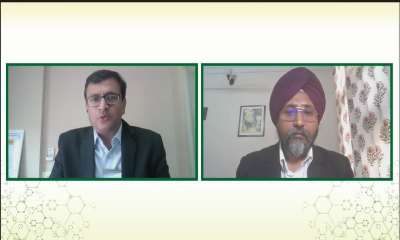The Active Pharma Ingredients (APIs) from pharmaceutical manufacturing facilities get disposed of in the wastewater often, mixing with multiple water bodies. Therefore, it is important to assess the concentration of these API losses. In this direction, the tools developed by the Pharmaceutical Supply Chain Initiative (PSCI) could help in the assessment, says Manjit Singh, Associate Director, Sustainability, Centrient Pharmaceuticals.
Singh spoke at the panel discussion on "Establishing Predicted Environmental Concentrations for API Loss from Pharma Manufacturing" as a part of the virtual event, ‘Innovations in green and sustainable chemistry for the pharma industry’ organized by Green ChemisTree Foundation on 19-20th January, 2022.
“The API losses are far less and can be measured in micrograms per liter. In pharmacopeia it is ppm (parts per million). Generally, the losses happen directly into water but in formulation it is cleaning losses. In the solid state, it is difficult to assess the losses if the dust collection is not proper. Lancet has published a report on antibiotics present in the water streams and becoming resistant. The antibiotic resistance is equivalent to a silent pandemic as people have started developing resistance against most advanced antibiotics. Among the causes, API losses from manufacturing is a small portion if we put all other ones due to agriculture, poultry and fishery together. It is in a higher spot due to gradual build up,” explains Manjit Singh.
“Since India supplies 70% of antibiotics to the world, there is a high concentration of antibiotics in water bodies. In this context, it is important to have focused policies. In countries such as Sweden and Norway, they are incentivizing those who ensure removal of residual antibiotics. Such companies are given 16 marks in the tenders floated by the government. In India, we could have a carbon credit like structure and implementation of measures by the National Green Tribunal could help in fixing residual limits. I believe that within 3-4 years we will see the right policies in place,” added Singh.
Elizabeth Girardi Schoen, Global Environment Leader, Pfizer said, “The companies must become responsible and minimize the API loss and its direct and indirect impact on the environment. It is important to devise proper methodology to determine how much is making way to the water and getting accumulated in the filters. We must ensure that predicted environmental concentrations should be lesser.”
“Mass API losses in manufacturing facilities need to be determined. We have an eight step process where the first one is selection of products for evaluation. For the mass balance process, the first step is to select the product and specific SKU for evaluation. Second step is to determine if API losses can be discharged to the environment. If possible, continue with the assessment and if not possible, skip the documentation. Third step is to obtain Predicted No effect Concentration (PNEC) and River Flow Information and select values based on company and/or PSCI. PSCI has established a PNEC calculator as a part of the process of establishing the losses. Step four is to obtain batch record information for selected products. The information can be used to calculate the eMax. The next few steps involve populating a block diagram with process loss information such as dust losses, solvent disposal, and cleaning removal. Eighth step is to document the results and assumptions using the standardized template,” says Jason Rushing, PE, Principal Engineer and PiE Subject Matter Expert, Arcadis.
"There may be multiple products made at your facility which contain the same API. We must carefully select the products being assessed so the Predicted Environmental concentration (PEC) estimate will be conservative. Choose the product with the highest initial conservative mass loss estimate (eMax). For example, a 500 MG tablet product has the highest API. Among the factors to consider when selecting a product for evaluation are mass of API per batch, number of batches per campaign, and concurrent manufacturing. Another important step initially is to determine if API losses are discharged to the environment via wastewater. In case it doesn’t, it needs to be confirmed process water is discharged onsite or offsite. Another step is to obtain PNEC and receive water body information to calculate PEC/PNEC ratio. If PNEC data is not available, the eMax and PEC can still be determined, says Nolan Chase, EIT, Consultant and PiE Specialist, Arcadis.
“While all losses are assumed to go to wastewater, one has to compile a list of API loss locations where API is lost during production and cleaning. It could be waste water, dust collection, solvent streams, cleaning material sent to hazardous waste. Estimating overhead dust losses can be done through three methods, viz dust collection experiment, estimate aggregate dust factor using waste records and removal percentage. This will require the inputs from in-house process experts,” adds Chase.

